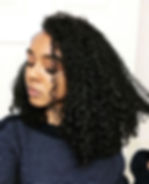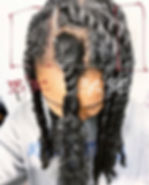*HEY CURLIES!! CHECK OUT MY UPDATED THOUGHTS ABOUT DETERMINING HAIR TYPE AT THE BOTTOM OF THIS BLOG, BY CLICKING HERE.
July, 29, 2020
So, I know a lot of people may not agree with this, but based on my experience it’s best not to even think about your hair type until you’ve grown out about 7-10 + inches of natural hair out.
Why Wait?

Because allowing time to pass for your hair to develop a pattern of some sort can help you start to analyze and detect which curl type you have.
You can see in the picture (from my transitioning days in 2017), how my hair looks wavy, as my curls meet my relaxed hair (1).
Then, you can see how thick my hair becomes and the density/pattern changes (2).
By the time you reach 10 inches +, your hair will most likely show your curl pattern clearly, especially, if you’ve found great products that work well and manage your hair while maintaining a routine.
So how do I pick products if I don’t know my hair type?
In the beginning, I assumed my hair was 3b/3c but I truly paid attention to the needs of my hair. I realized that it got dry after a wash and realized how hard it was to detangle.
I also tried A LOT of products during my transition phase and realized the more natural the product, the better my hair reacted to it.
Eventually, I stripped away chemically based products until they became more and more naturally pure.
So, I still don’t know what my hair type is...
This can be tricky. Technically, when looking at the very specific descriptions of what classified as “wavy, curly, and kinky” you can easily notice how hair doesn’t always fit into those molds.
My hair is wavy and then curls at the ends, so what’s my hair type? There are some factors to consider when determining hair type, so let’s review...
The Shape
Looking at a glance, I have 3a-3c curls. However, when looking closely, you can notice that I have an ‘S’ shape which really classifies as a wave. My hair based on shape, would be considered type 2.

However, that isn’t the only thing to factor in when you’re figuring out your hair type.
You also have to consider the density, size of the shapes of your curls, waves, and kinks, and then also coarseness plays a part in this too!
My hair has an 'S' shape (1) that turns into type 3 curls (2). My hair pattern shape is also smaller than what is suggested to be type 2 hair.
Type 3 hair are of the smaller types of curls or waves. This is why my hair type (at a glance) would be considered type 3, because my curls are smaller than type 2 waves and larger than type 4 coils.
However, as we go through all the many aspects that contribute to hair type, you’ll see my hair is not just made up of type 3 curls!
My hair is an example that hair type may not check all the boxes of what constitutes as “type 2, type 4, type-whatever-number” hair.
Curly hair is unique to each person and cannot always fit into one diagram.
So no worries if yours doesn’t either! Now, let’s talk about coarseness.
Fine vs. Coarse Hair
Your hair is defined as fine or coarse (not based on if it is straight or curly, but rather) on the thickness of your hair strands.

Many forget to consider this when looking at their hair type/curl pattern.
My hair is generally medium/coarse. There are areas where my hair that are very fine and are 2c (the area that looks "damaged" in the still shot is my 2c hair when wet).
Then there are areas where my hair is fine and 4a (see the picture below—my hair is wet, but when dry it shrinks, A LOT—resembling 4a hair).
Do not confuse density with fine, medium, or coarse hair types!
This is why it is important to just listen to YOUR hair. It's possible to have thin, coarse hair OR dense, fine hair.
For example, a person may have similar curls/curl shape to you, say they are 3b.

However, your hair may be fine and thin, while their hair is coarse and dense, but you both share type 3b curls.
It is also important to note that curl patterns change when they are wet, damp, and when they are fully dry.
Density
This refers to hair much hair you have in so many words.
Think of a lace front wig. When you see a wig with low density, you can see more of the lace, than you can with a highly dense wig.
My hair is medium to high density. I have many strands that are close together, creating thick hair.

If you have low density, your hair is thin, if you have medium density your hair is not quite thick but in between and if you have high density your hair is thick.
There are portions of my hair where it is medium density (such as the front area of my hair and the crown of my head is the thickest, making it highly dense—I always need more product here).
Determining How Fine/Coarse and The Density of Your Hair
You can determine if you have fine or coarse hair if you take a strand of your hair and put it between two fingers. If you can sightly to not at all feel your hair between your fingers, then your hair is fine.

If you feel your strand but it's not thick or thin then you have medium hair and if you most definitely feel a thick piece of hair between your fingers, you have coarse hair.
The density of your hair is the easiest to determine, because it is knowing if you have thin, medium, thick, or super thick hair.
This picture is from my transitioning days in 2016 and you can see how many hair follicles I have.
And, not to mention, this is my hair when wet!
My hair strands are very close together making my scalp less visible, making my hair highly dense. (Looking toward my baby hairs, you can see how you can see more of my scalp so my hair is less dense in that area).
Figuring Out Your Hair Type
If we look at all of this information, from the shape of your hair, type of hair level, the fineness or coarseness of your hair, the ability to retain moisture, the density of your hair, then you can determine your true hair type!
This is why it's important not to just take what others say online (or anywhere) and determine what works for you by listening to YOUR hair!

Like I said, remember that these are cookie-cutter diagrams suggesting the common curl patterns, not all the unique ones in between.
And, not to mention, hair diagrams from professionals, curly hair experts based on experience, to bloggers, you can see so many charts showing different representations of what each type of curl/hair type looks like.
And, like myself, many people may not fit into the hair molds that are being displayed.
It is POSSIBLE to have several hair types, porosities, and variations and still have a healthy scalp/healthy hair!
Nothing is wrong with you.
Now, if you experience a drastic change in your hair (such as your pattern changes immensely, from 3c to 2b within a few months and treat your hair well, with no heat etc, it may be an underlying issue and this is the area that I am truly unsure about and you may have to consult a professional).
(All of my advice and suggestions are due to my experience with hair over the years and are not based on professional knowledge.)
So let's look at my hair type to make sure we got this down—so you can determine yours!
The majority of my hair is medium porosity (besides my 4a babes near the nape of my neck, they sometimes can get dry).

I have a lot of hair (medium/high density) with mainly medium porosity, no matter what curl type I have.
The portion of hair behind my ears is 2c fine hair. My hair on the crown of my head is 3a/3b medium hair. The hair strands on the crown of my head, is thicker than that behind my ears. Near the front of my head, my hair is 3b/3c medium hair.
The nape of my neck, as I said is 4a, HOWEVER, it is fine hair. Yes, it is possible to have fine 4 type curls!
My baby hairs vary from fine to coarse! Some of them are hard to lay down and don't listen to me. It's a pain when trying to slick them back. The best products for coarse hair will moisturize and control frizz.
Overall, I have mainly high density, with mostly medium hair follicles, that are medium porosity, ranging from mainly 3b-4a hair.
This is the answer I give to most of my curlies that ask me questions, because it's easier to explain, then relay all that info above!
UPDATE 09/10/21:
And while all the above is something to consider, as my hair grows longer and as I learn more about the many textures one can be blessed with, I've figured out that sometimes typing hair can get in the way of truly taking great care of your curls.
Now, instead of going with specific curl class, I go with the general hair types my hair is somewhat similar to (Type 3/4), (if someone asks)!
In reality, living day-to-day life, typing hair doesn't help you take better care of your curls, but it does help give you an idea of what to expect based on what your hair pattern looks or may act similar to, when just starting the natural hair journey!
Over the past year, as my hair grew through another growth spurt, I've realized how helpful typing my curl pattern was at the beginning of my journey, but not so much later on.
I feel in the long-run, getting caught up into the various consistencies and factors that contribute to hair type (like described above) can be counter effective! The major things to get to know about your hair are:
Hair Porosity: So you understand how products are interacting with your hair
Moisturizing vs. Sealing oils: So you know which oils may be best for retaining moisture
Skin and scalp type: So you can know how oils and products are interacting and impacting your skin and scalp health
The ingredients you're putting in your hair: So paying attention to what products you are using and how natural and chemical-free your hair care routine is a great thing to know when it comes to curl (and really general hair) health!
How to protect it: So you can give your hair a break when needed and retain healthy curls and length (if length is a goal!)
In summary curlfriends, there are just so many unique types of curls, it's hard to really figure out how we can fit in these boxes that were created for us! Moral of the story is get to know your hair and what it loves and you're headed in the right healthy curls direction!
Until next time,
The Curlfriend
P.S. Ya beauty blogger turned consultant is now offering services to business owners who are looking for harmony in building a life in harmony with their business visions. I'm seeking 10 heart-centered leaders looking to uplevel their lives and business.
Together we'll reenergize you, your team, and your business so it works for you, not the other way around. I mean the whole reason people start a business is to have more freedom, and that's what I'm here to help you achieve. — Aziza Ransome, PsyM aka the brain behind The Curlfriend







